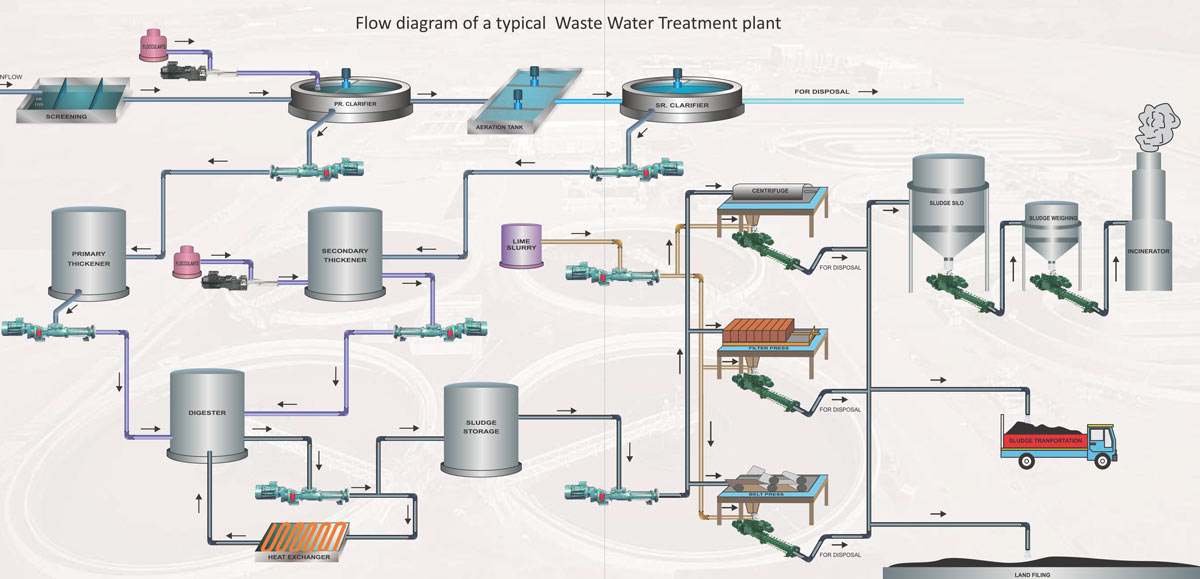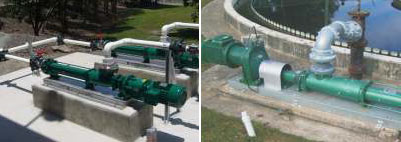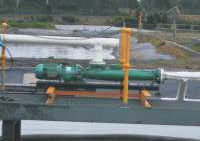Wastewater Pumps Manufacturers
Wastewater Pumps are also known as Sewage Pumps. These pumps are used to transfer filthy and grimy liquids often containing solid particles, like sewage, sludge and waste water. These kinds of pumps are suitable for a number of applications such as waste water treatment, sewage treatment, waste water reuse, dewatering etc.
Roto waste water pump design is same as of progressive cavity pump. A single helix metallic rotor rotates inside a double helix elastomeric stator to generate cavities along their axis. The liquid is then pumped from suction end, travels through these cavities and get released from the discharge end of the pump. These pumps also comprise of a cardan universal joints, pump housing, coupling rod and stub shaft.
Roto Pumps is one of the leading Waste Water Pumps manufacturers. Roto’s pumps can easily handle the transfer of liquids with corrosive and abrasive constituents. Each of these sturdy pumps are especially designed to meet the individual needs of the customers.
The prime objective of industrial wastewater plant is to reduce the sludge volume and separate the water from the matter to efficiently treat the sludge and enhance the quality of disposal and producing renewable energy i.e. BIOGAS, Methane, Compost, etc.
The first stage in WWTP is to remove large coarse objects which can cause damage to the pumping system due to their size. The sewage water flows through installed bar screens to remove the large floating objects such as rags and screens, undigested foods, match sticks, etc. and some fibrous items are even macerated to make them suitable for transferring with progressive cavity pumps. In this step sewage water also flows through gravel chambers for settling the grit out of water
Primary sludge constitutes 99% water and 1% solids. To reduce the treatment cost, wastewater plant reduces the water content by primary, secondary and territory thickening processes. Thickening the liquid-solid sludge by 3 to 5% will reduce the overall volume by more than 50%.
The process involves Dissolved Air Flotation and Gravitational Thickening processes for removal of 30%-60% of suspended solids & reduces the BOD demand. The sewage is often chlorinated in order to sterilize the waste & destroy the bacteria.
Dissolved Air Flotation Thickening works by forcing air under pressure to dissolve in the return flow and releasing the pressure as the return is mixed with the feed. As the air comes out of the waste, solids get attached to tiny bubbles and float to the top of the tank to be scrapped off. The flotation process allows free passage for solids less than 5cm to the settling tank.
Gravity thickening reduces the natural tendency of higher-density solids to settle out of liquid to concentrate the solids. It is used in sedimentation/settling tanks in which high density organic and inorganic solid separates from the liquid by settling at the bottom. Other solid materials having properties similar to water are skimmed out to the next secondary treatment stage. The settled bio-solids are further treated and used as fertilizer where rest is land disposed.
Secondary Treatment/ Activated Sludge Process remove 85% of organic matter with the use of aerobic &anaerobic bacteria.
Anaerobic Biological Process is an energy-efficient process in which micro-organism transform organic matter into methane-rich biogas & carbon dioxide in the oxygen-free environment.
Aerobic Biological process requires blowing air with the presence of oxygen in settling tanks where bacteria break down the organic matter and remove pollutants like nitrogen and phosphorus. The aerobic process is used to achieve maximum degradation and convert biomass into carbon dioxide & new biomass.
After the biological process, the excel sludge settled in sedimentation tanks is pumped to Digestion Tankswhere sludge is heated and mixed to produce biogas which can be reused by wastewater plants for renewable energy production. And the rest effluent wastewater is injected with chlorine to remove harmful diseases cause organisms before releasing into waterways.
Storage tanks are used for second stage digestion where water is separated from semi-solid sludge and goes for further treatment and semi-solid sludge is pumped to dewatering facility.
Digested Sewage Sludge is dewatered before final disposal. The residual sludge from digestion tanks has solids no use which contains 70% water content. Although the sludge still feels like solid, but its volume needs to be removed before final disposal.
Different Methods For Dewatering
Open Sand Beds: The digested wastewater sludge is spread over an open bed of sand where its water content is evaporated via sunlight and rest water is drained with a piping system underneath the sand bed. Six weeks of drying reduced the water part to 40%. This method is widely adopted in small rural waste plants.
Flocculent Chemical Dosing: Other Drying methods such as Rotary Drum Vacuum Filter, Centrifugation and Belt Filter process requires chemical conditioned sludge where a dosing pump transfer flocculants into sludge produced from digestion tanks and screw pump transfer it to the dewatering unit.
Rotary Drum Vacuum Filter: A submerged drum rotates in wastewater sludge & its each revolution consists of sludge drying, cake formation and cake disposal. The vacuum is applied by means of liquid ring vacuum pump and it draws liquid via filter medium on the drum surface which retains the solids. The vacuum continues to remove moisture from the cake and the resultant cake is deposed from drum to conveyor belt.
Belt Filter Press: The chemical condition sludge is conveyed along the belt and plough rolls to drain water out. Guide plates are used to position the sludge onto the middle of the belt so that squeezing does not take place outside the filter. After this stage, the solids are prepared to enter into the pressure zone, where the sludge is sandwiched between two belt filters and medium to high pressure is applied resulting in more drainage of water. The resulting water is again transferred to the starting of the primary treatment unit of wastewater plant and sludge cake is disposed.
Centrifugation Process: In the process, sludge is transferred into a centrifuge where its internal drum rotates at a high speed of 3000rpm or more. The feeding rate is kept constant and the solids with the size of 2 µm and above gets deposited on drum inner wall in the form of stable sludge with 20% water content and the hydraulic energy in the drum allows a collecting pipe to collect clean water and transport it to collecting tank without any pump.
We provide initial training services during product installation to acquaint your team with your pump and its operations.
| APPLICATION AREAS | PUMP TYPE | ||
|---|---|---|---|
| RM | RL | RD | |
| Bilge | √ | √ | √ |
| Black & grey water | √ | √ | √ |
| Brine | √ | √ | √ |
| Dirty oil | √ | √ | √ |
| Furnace oil | √ | √ | √ |
| HSD | √ | √ | √ |
| LDO | √ | √ | √ |
| LSHS | √ | √ | √ |
| Mud | √ | √ | √ |
| Offshore recovered oil | √ | √ | √ |
| Oily bilge | √ | √ | √ |
| Sewage | √ | √ | √ |
| Sludge | √ | √ | √ |
| Turbine oil | √ | √ | √ |
| Contaminated water | √ | √ | √ |
| Fecal matters | √ | √ | √ |
| Kitchen waste | √ | √ | √ |
| Polymer | √ | √ | √ |
| Sea water | √ | √ | √ |







